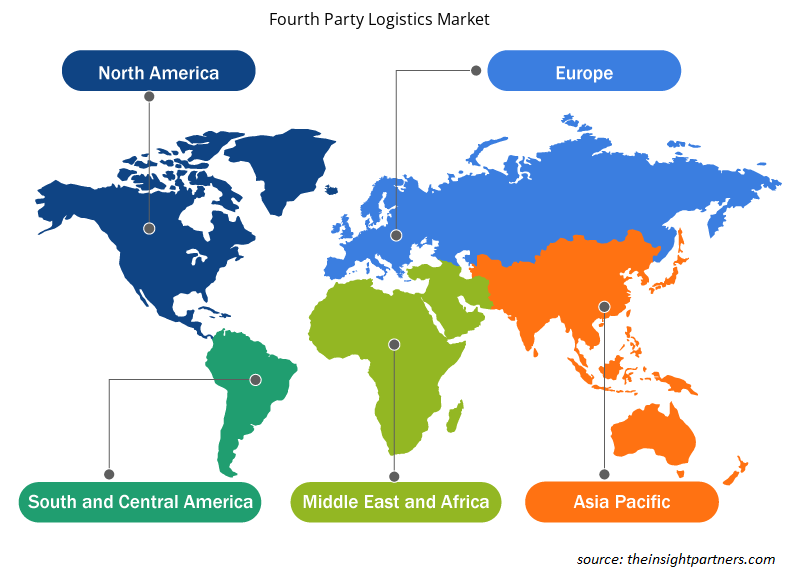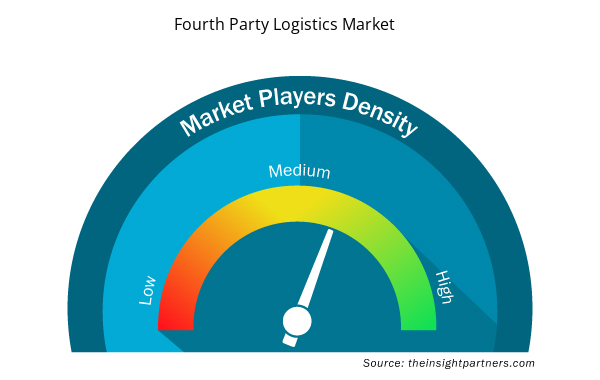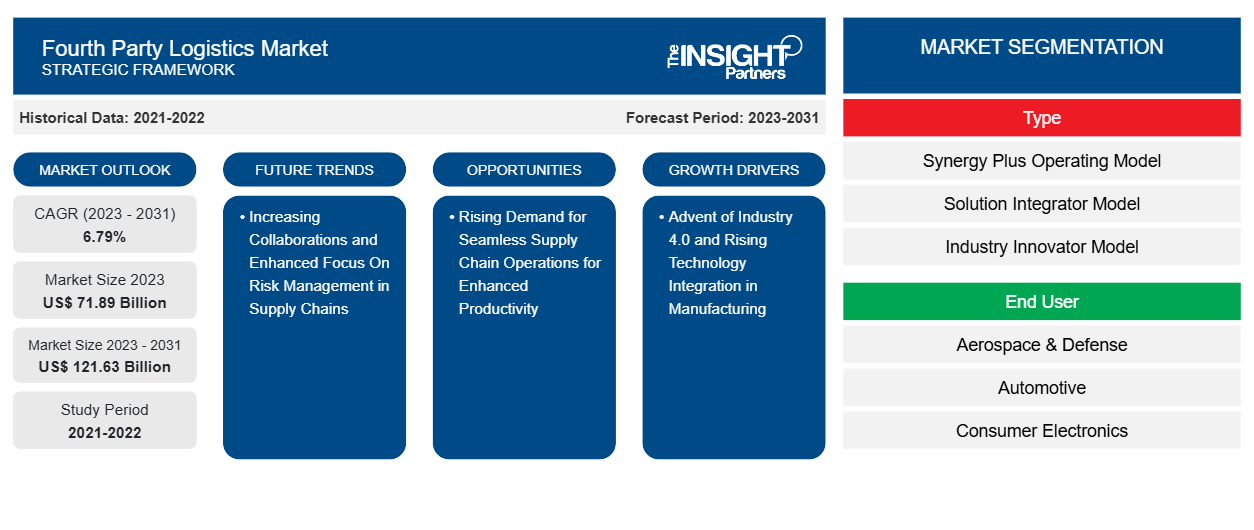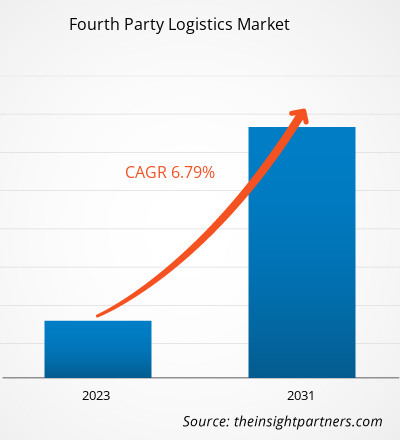第四次物流市場規模は、2023年の718億9,000万米ドルから2031年には1,216億3,000万米ドルに達すると予測されています。市場は2023年から2031年にかけて6.79%のCAGRを記録すると予想されています。
インダストリー4.0の登場により、製造業はデジタル変革を遂げました。さまざまな企業がこのような高度なデジタル技術の力を活用し、さまざまなサプライチェーンプロセスを合理化することで、顧客企業に競争上の優位性を提供しています。
フォース・パーティ・ロジスティクス市場分析
4PL サービス市場の成長には、地域の人口統計も重要な役割を果たしていることがわかっています。たとえば、小売業では 4PL の採用が進んでおり、e コマースの出現によりそれが強化されています。APAC 地域は世界人口の 3 分の 1 以上を占めているため、e コマース業界の市場魅力はこの地域で非常に高くなっています。さらに、経済発展と個人の可処分所得の増加が、e コマース業界の成長をさらに推進しています。
この地域で見られる多様な人口構成により需要の多様性が高まり、サプライ チェーンの複雑さが増しています。このような複雑なサプライ チェーンにより、運送会社が展開する 4PL サービスに対するニーズが高まっています。過去 10 年間、デジタル技術の採用が進み、技術がさらに強化されたことで、さまざまなエンド ユーザー 業界の需要が大幅に加速しています。この市場の主要プレーヤーは、現在の製品ポートフォリオを拡大し、顧客ベースを多様化し、新しいアプリケーションや市場を開発することで、対象市場を拡大し続けており、すべての主要プレーヤーは激しい競争に直面しています。
フォース・パーティ・ロジスティクス市場の概要
サプライ チェーン管理の分野でより知識のあるパートナーにサプライ チェーン機能全体をアウトソーシングすると、ラスト マイル配送に伴う複雑さが軽減されます。物流のアウトソーシングによって得られる無形のメリットには、コスト削減、人的資本の節約、運転資本の固定化の回避、顧客ネットワークへのアクセスの向上などがあります。
フォースパーティロジスティクスの概念の出現は、本質的に、ますます複雑化するサプライチェーン環境における上記のすべてのボトルネックを取り除くための動きでした。フォースパーティロジスティクス (4PL) サービスは、サービスとしてのサプライチェーンとも呼ばれ、4PL プロバイダーが顧客企業のロジスティクス部門と統合します。これにより、4PL サービスプロバイダーは、注文管理から倉庫保管、コンプライアンス規制からサプライヤー管理まで、サプライチェーンに関係するすべての業務に実践的なアプローチをとることができます。4PL サービスプロバイダーは、多数のサプライチェーンプロバイダーとクライアント組織の間のインターフェイスの単一のリンクとして機能します。これにより、4PL プロバイダーは高度なリソースを使用してすべての業務を管理し、最適化して顧客に価値を提供します。
要件に合わせてレポートをカスタマイズする
このレポートの一部、国レベルの分析、Excelデータパックなど、あらゆるレポートを無料でカスタマイズできます。また、スタートアップや大学向けのお得なオファーや割引もご利用いただけます。
- このレポートの主要な市場動向を入手してください。この無料サンプルには、市場動向から見積もりや予測に至るまでのデータ分析が含まれます。
第四次物流市場の推進要因と機会
インダストリー4.0の到来と製造業における技術統合の高まり
高度なソフトウェア、クラウド コンピューティング、ビッグ データなどの新しいデジタル テクノロジーは、4PL サービス プロバイダーがサプライ チェーン全体の可視性を維持し、可視性、透明性、運用、生産性を向上させるために大いに活用できます。さらに、モノのインターネット (IoT)、自動化、ロボットなどのテクノロジーが注目されるようになるにつれて、組織による 4PL 導入のニーズが急速に高まることが予想されます。
生産性向上のためのシームレスなサプライチェーン運用の需要の高まり
サプライ チェーンでは、可動部品が、自然災害、地政学的緊張、環境問題、関税関連の複雑さ、規制、コンプライアンスの変動など、予測できない状況に左右されることがあります。さらに、サプライ チェーンの断片化により、関係する組織間のコミュニケーションと透明性が欠如します。現在の消費者の需要は非常に動的であり、消費者側の小さな不満でさえ、会社の収益に大きな影響を与える可能性があります。製品のオンデマンド配送の急速な増加により、今日の企業は従来の社内物流モデルから、より高度でコスト効率の高いアウトソーシングまたは契約ベースの物流モデルに移行しています。
第四次物流市場レポートのセグメンテーション分析
第四次物流市場分析の導出に貢献した主要なセグメントは、タイプとエンドユーザーです。
- タイプに基づいて、市場はシナジープラス運用モデル、ソリューションインテグレーターモデル、業界イノベーターモデルに分割されています。ソリューションインテグレーターモデルセグメントは、2023年に大きな市場シェアを占めました。
- エンドユーザーに基づいて、市場は航空宇宙および防衛、自動車、家電、食品および飲料、工業、ヘルスケア、小売、その他に分類されます。小売セグメントは2023年に市場で最大のシェアを占めました。
地域別第四次物流市場分析
第四次物流市場レポートの地理的範囲は、主に北米、ヨーロッパ、アジア太平洋、中東およびアフリカ、南米の 5 つの地域に分かれています。
第四次物流市場レポートの対象範囲は、北米(米国、カナダ、メキシコ)、欧州(スペイン、英国、ドイツ、フランス、イタリア、その他の欧州)、アジア太平洋(韓国、中国、インド、日本、オーストラリア、その他のアジア太平洋)、中東およびアフリカ(南アフリカ、サウジアラビア、UAE、その他の中東およびアフリカ)、南米および中米(ブラジル、アルゼンチン、その他の南米および中米)です。収益面では、2023年に第四次物流市場シェアはアジア太平洋が独占しました。欧州は世界の第四次物流市場への第2位の貢献国であり、北米がそれに続きます。
経済的に繁栄している北米地域は、米国とカナダの高度に先進的な経済圏で構成されています。米国とカナダの先進経済圏では、工業化が依然として高い優先順位にあり、長年にわたり経済を牽引する主な要因でもあります。米国は、世界で最も技術的に先進的な自動車、ヘルスケア、航空宇宙および防衛、および消費者向け電子機器の分野を誇っていると言われています。大量製造業と世界の他の国々と行われる関連貿易により、北米地域は輸送および物流ベースのサービスの戦略的ハブとなっています。経済的に先進的な北米の企業は、輸送および物流ベースの活動に費やす予算が大きく、したがって、第4者物流市場の発展に貢献しています。北米に確立されたデジタルインフラストラクチャが存在することで、物流プロビジョニングサービスに関連する視野の拡大がさらに強調されます。タイプ(シナジープラスオペレーティングモデル、ソリューションインテグレーターモデル、および業界イノベーターモデル);エンドユーザー(航空宇宙・防衛、自動車、家電、食品・飲料、工業、ヘルスケア、小売など)
フォース・パーティ・ロジスティクス市場の地域別分析
予測期間を通じて第四者物流市場に影響を与える地域的な傾向と要因は、Insight Partners のアナリストによって徹底的に説明されています。このセクションでは、北米、ヨーロッパ、アジア太平洋、中東、アフリカ、南米、中米にわたる第四者物流市場のセグメントと地理についても説明します。

- 第四次物流市場の地域別データを入手
フォース・パーティ・ロジスティクス市場レポートの範囲
| レポート属性 | 詳細 |
|---|---|
| 2023年の市場規模 | 718.9億米ドル |
| 2031年までの市場規模 | 1,216.3億米ドル |
| 世界のCAGR(2023年~2031年) | 6.79% |
| 履歴データ | 2021-2022 |
| 予測期間 | 2023-2031 |
| 対象セグメント | タイプ別
|
| 対象地域と国 | 北米
|
| 市場リーダーと主要企業プロフィール |
|
第四次物流市場のプレーヤー密度:ビジネスダイナミクスへの影響を理解する
フォース パーティ ロジスティクス市場は、消費者の嗜好の変化、技術の進歩、製品の利点に対する認識の高まりなどの要因により、エンド ユーザーの需要が高まり、急速に成長しています。需要が高まるにつれて、企業は提供内容を拡大し、消費者のニーズを満たすために革新を起こし、新たなトレンドを活用し、市場の成長をさらに促進しています。
市場プレーヤー密度とは、特定の市場または業界内で活動している企業または会社の分布を指します。これは、特定の市場スペースに、その規模または総市場価値と比較して、どれだけの競合相手 (市場プレーヤー) が存在するかを示します。
第四次物流市場で事業を展開している主要企業は次のとおりです。
- アリンインターナショナルサービス
- 株式会社
- ユナイテッド・パーセル・サービス
- 株式会社
- ジェフコグループ
免責事項:上記の企業は、特定の順序でランク付けされていません。

- 第四次物流市場のトップキープレーヤーの概要を入手
フォース・パーティ・ロジスティクス市場のニュースと最近の動向
フォース パーティ ロジスティクス市場は、主要な企業出版物、協会データ、データベースなどの一次調査と二次調査後の定性的および定量的データを収集することによって評価されます。以下は、フォース パーティ ロジスティクス市場の動向と戦略のリストです。
- 2023年12月、北米のLTL貨物輸送の大手プロバイダーであるXPO(NYSE:XPO)は、デラウェア州連邦破産裁判所が、以前Yellow Corporationが運営していた28のサービスセンターを買収するという同社の申し出を承認したことを発表しました。XPOは26のサービスセンターを購入し、残りの2つの場所の既存のリースを引き継ぎます。取引は2023年末までに完了する予定です。(出典:XPO、プレスリリース/会社ウェブサイト/ニュースレター)
フォース・パーティ・ロジスティクス市場レポートの対象範囲と成果物
「第四次物流市場の規模と予測(2021〜2031年)」レポートでは、以下の分野をカバーする市場の詳細な分析を提供しています。
- 対象範囲に含まれるすべての主要市場セグメントの世界、地域、国レベルでの市場規模と予測
- 市場の動向(推進要因、制約、主要な機会など)
- 今後の主な動向
- ポーターのファイブフォース分析の詳細
- 主要な市場動向、主要プレーヤー、規制、最近の市場動向を網羅した世界および地域の市場分析
- 市場集中、ヒートマップ分析、主要プレーヤー、最近の動向を網羅した業界の状況と競争分析
- SWOT分析による詳細な企業プロフィール
- 過去2年間の分析、基準年、CAGRによる予測(7年間)
- PEST分析とSWOT分析
- 市場規模価値/数量 - 世界、地域、国
- 業界と競争環境
- Excel データセット



Report Coverage
Revenue forecast, Company Analysis, Industry landscape, Growth factors, and Trends

Segment Covered
This text is related
to segments covered.

Regional Scope
North America, Europe, Asia Pacific, Middle East & Africa, South & Central America

Country Scope
This text is related
to country scope.
Trends and growth analysis reports related to Automotive and Transportation : READ MORE..
The Insight Partners performs research in 4 major stages: Data Collection & Secondary Research, Primary Research, Data Analysis and Data Triangulation & Final Review.
- Data Collection and Secondary Research:
As a market research and consulting firm operating from a decade, we have published and advised several client across the globe. First step for any study will start with an assessment of currently available data and insights from existing reports. Further, historical and current market information is collected from Investor Presentations, Annual Reports, SEC Filings, etc., and other information related to company’s performance and market positioning are gathered from Paid Databases (Factiva, Hoovers, and Reuters) and various other publications available in public domain.
Several associations trade associates, technical forums, institutes, societies and organization are accessed to gain technical as well as market related insights through their publications such as research papers, blogs and press releases related to the studies are referred to get cues about the market. Further, white papers, journals, magazines, and other news articles published in last 3 years are scrutinized and analyzed to understand the current market trends.
- Primary Research:
The primarily interview analysis comprise of data obtained from industry participants interview and answers to survey questions gathered by in-house primary team.
For primary research, interviews are conducted with industry experts/CEOs/Marketing Managers/VPs/Subject Matter Experts from both demand and supply side to get a 360-degree view of the market. The primary team conducts several interviews based on the complexity of the markets to understand the various market trends and dynamics which makes research more credible and precise.
A typical research interview fulfils the following functions:
- Provides first-hand information on the market size, market trends, growth trends, competitive landscape, and outlook
- Validates and strengthens in-house secondary research findings
- Develops the analysis team’s expertise and market understanding
Primary research involves email interactions and telephone interviews for each market, category, segment, and sub-segment across geographies. The participants who typically take part in such a process include, but are not limited to:
- Industry participants: VPs, business development managers, market intelligence managers and national sales managers
- Outside experts: Valuation experts, research analysts and key opinion leaders specializing in the electronics and semiconductor industry.
Below is the breakup of our primary respondents by company, designation, and region:

Once we receive the confirmation from primary research sources or primary respondents, we finalize the base year market estimation and forecast the data as per the macroeconomic and microeconomic factors assessed during data collection.
- Data Analysis:
Once data is validated through both secondary as well as primary respondents, we finalize the market estimations by hypothesis formulation and factor analysis at regional and country level.
- Macro-Economic Factor Analysis:
We analyse macroeconomic indicators such the gross domestic product (GDP), increase in the demand for goods and services across industries, technological advancement, regional economic growth, governmental policies, the influence of COVID-19, PEST analysis, and other aspects. This analysis aids in setting benchmarks for various nations/regions and approximating market splits. Additionally, the general trend of the aforementioned components aid in determining the market's development possibilities.
- Country Level Data:
Various factors that are especially aligned to the country are taken into account to determine the market size for a certain area and country, including the presence of vendors, such as headquarters and offices, the country's GDP, demand patterns, and industry growth. To comprehend the market dynamics for the nation, a number of growth variables, inhibitors, application areas, and current market trends are researched. The aforementioned elements aid in determining the country's overall market's growth potential.
- Company Profile:
The “Table of Contents” is formulated by listing and analyzing more than 25 - 30 companies operating in the market ecosystem across geographies. However, we profile only 10 companies as a standard practice in our syndicate reports. These 10 companies comprise leading, emerging, and regional players. Nonetheless, our analysis is not restricted to the 10 listed companies, we also analyze other companies present in the market to develop a holistic view and understand the prevailing trends. The “Company Profiles” section in the report covers key facts, business description, products & services, financial information, SWOT analysis, and key developments. The financial information presented is extracted from the annual reports and official documents of the publicly listed companies. Upon collecting the information for the sections of respective companies, we verify them via various primary sources and then compile the data in respective company profiles. The company level information helps us in deriving the base number as well as in forecasting the market size.
- Developing Base Number:
Aggregation of sales statistics (2020-2022) and macro-economic factor, and other secondary and primary research insights are utilized to arrive at base number and related market shares for 2022. The data gaps are identified in this step and relevant market data is analyzed, collected from paid primary interviews or databases. On finalizing the base year market size, forecasts are developed on the basis of macro-economic, industry and market growth factors and company level analysis.
- Data Triangulation and Final Review:
The market findings and base year market size calculations are validated from supply as well as demand side. Demand side validations are based on macro-economic factor analysis and benchmarks for respective regions and countries. In case of supply side validations, revenues of major companies are estimated (in case not available) based on industry benchmark, approximate number of employees, product portfolio, and primary interviews revenues are gathered. Further revenue from target product/service segment is assessed to avoid overshooting of market statistics. In case of heavy deviations between supply and demand side values, all thes steps are repeated to achieve synchronization.
We follow an iterative model, wherein we share our research findings with Subject Matter Experts (SME’s) and Key Opinion Leaders (KOLs) until consensus view of the market is not formulated – this model negates any drastic deviation in the opinions of experts. Only validated and universally acceptable research findings are quoted in our reports.
We have important check points that we use to validate our research findings – which we call – data triangulation, where we validate the information, we generate from secondary sources with primary interviews and then we re-validate with our internal data bases and Subject matter experts. This comprehensive model enables us to deliver high quality, reliable data in shortest possible time.


 このレポートの無料サンプルを入手する
このレポートの無料サンプルを入手する